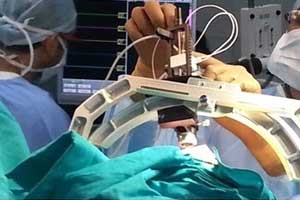- Home
- Editorial
- News
- Practice Guidelines
- Anesthesiology Guidelines
- Cancer Guidelines
- Cardiac Sciences Guidelines
- Critical Care Guidelines
- Dentistry Guidelines
- Dermatology Guidelines
- Diabetes and Endo Guidelines
- Diagnostics Guidelines
- ENT Guidelines
- Featured Practice Guidelines
- Gastroenterology Guidelines
- Geriatrics Guidelines
- Medicine Guidelines
- Nephrology Guidelines
- Neurosciences Guidelines
- Obs and Gynae Guidelines
- Ophthalmology Guidelines
- Orthopaedics Guidelines
- Paediatrics Guidelines
- Psychiatry Guidelines
- Pulmonology Guidelines
- Radiology Guidelines
- Surgery Guidelines
- Urology Guidelines
World's first robotic neurosurgery inside MRI Scanner

The first neurosurgical robotic system capable of performing bilateral stereotactic neurosurgery inside a magnetic resonance imaging (MRI) scanner has been designed by a team of mechanical engineers from HKU, led by Dr. Ka-Wai Kwok. This innovative technological breakthrough can facilitate the treatment of Parkinson's disease and other neuropsychiatric disorders. A pre-clinical validation of the system was also done with CUHK neurosurgeons, Dr. Danny Tat-Ming Chan and Professor Wai-Sang Poon.
The team was conferred the Best Conference Paper Award in the largest international forum for robotics scientists, the IEEE International Conference on Robotics and Automation 2018 (ICRA'18), which was held in Brisbane, Australia.
The study is published in the journal IEEE Robotics and Automation Letters.
Stereotactic neurosurgery is one of the treatment to a variety of neuropsychiatric and movement disorders such as Parkinson's disease (PD), essential tremor and major depression. It involves a technique that can locate targets of surgical interest using an external positioning system, which is widely applied in brain biopsy, tumor ablation, drug delivery, as well as deep brain stimulation (DBS).
Parkinson's disease alone is the second most common disease of the nervous system after Alzheimer's disease and is projected to affect over 8.7 million people worldwide by 2030. As such, any improvement to this surgery would benefit a large population.
DBS therapy, like a heart pacemaker, can deliver electrical signals through implanted electrodes to the deep brain targets. It helps to restore normal nerve cell activity. This surgery is tremendously demanding on accuracy, by targeting only the tiny nucleus structures and not damaging the surrounding critical tissue. Without the intra-operative updates of a surgical "roadmap," the brain may shift after the skull is opened and inevitably lowers the targeting accuracy.
Conventional DBS is performed while the patient is awake under local anesthesia. Surgeons have to rely on verbal or physical interactions with the patients to ensure the electrode placement is going well. These surgical complications motivated the HKU-led team to develop a compact robot guided by MRI. This facilitates less invasive stereotactic procedures on the patient under general anesthesia, as surgeons could accurately control and evaluate the stereotactic manipulation bilaterally to the left and right brain targets in real time.
The team successfully resolved many unmet technical challenges. For example, MRI scanners have very strong magnetic fields and most metallic components are forbidden in MRI environments, including the electromagnetic (EM) motors commonly used in robots. The team has developed a totally magnetic resonance (MR) compatible teleoperated system driven by liquid. It does not generate any EM interference or affect imaging quality even during the robot operation. A manipulator is designed to perform dexterous operation towards the left-and-right brain targets, and the area required for an invasive anchorage is very small. The compact robot design can be accommodated inside a standard MRI head coil for imaging and intervention. Advanced 3-D tracking markers are also developed, which enable fast localization of robot instruments in MRI in real time.
The success of this project would represent a major step towards safer, more accurate and effective brain surgery. It is believed that all these components can be applied to other interventions requiring MRI guidance, e.g. cardiac catheterization, prostate or breast biopsy. The research team plans to conduct further clinical studies to determine the efficacy of the system.
For more information log on to 10.1109/LRA.2018.2814637

Disclaimer: This site is primarily intended for healthcare professionals. Any content/information on this website does not replace the advice of medical and/or health professionals and should not be construed as medical/diagnostic advice/endorsement or prescription. Use of this site is subject to our terms of use, privacy policy, advertisement policy. © 2020 Minerva Medical Treatment Pvt Ltd